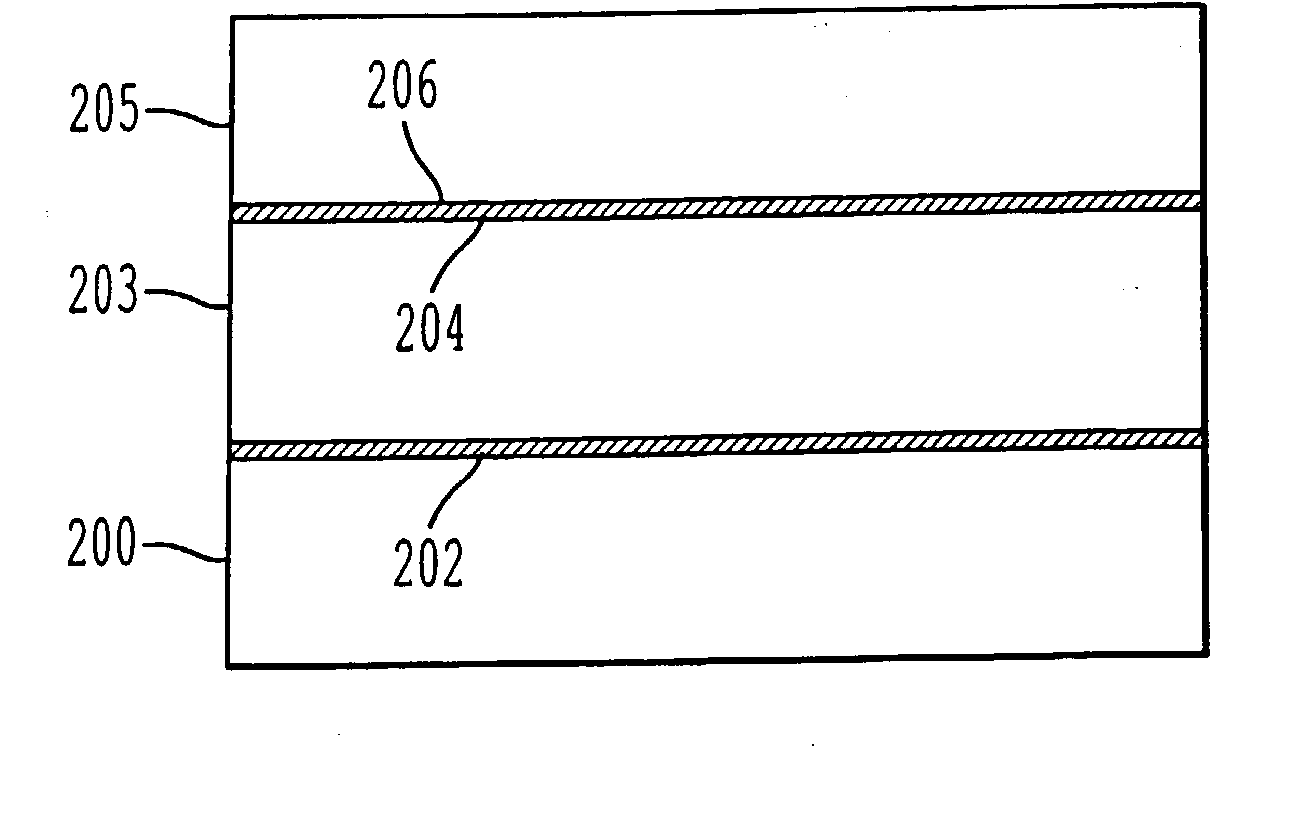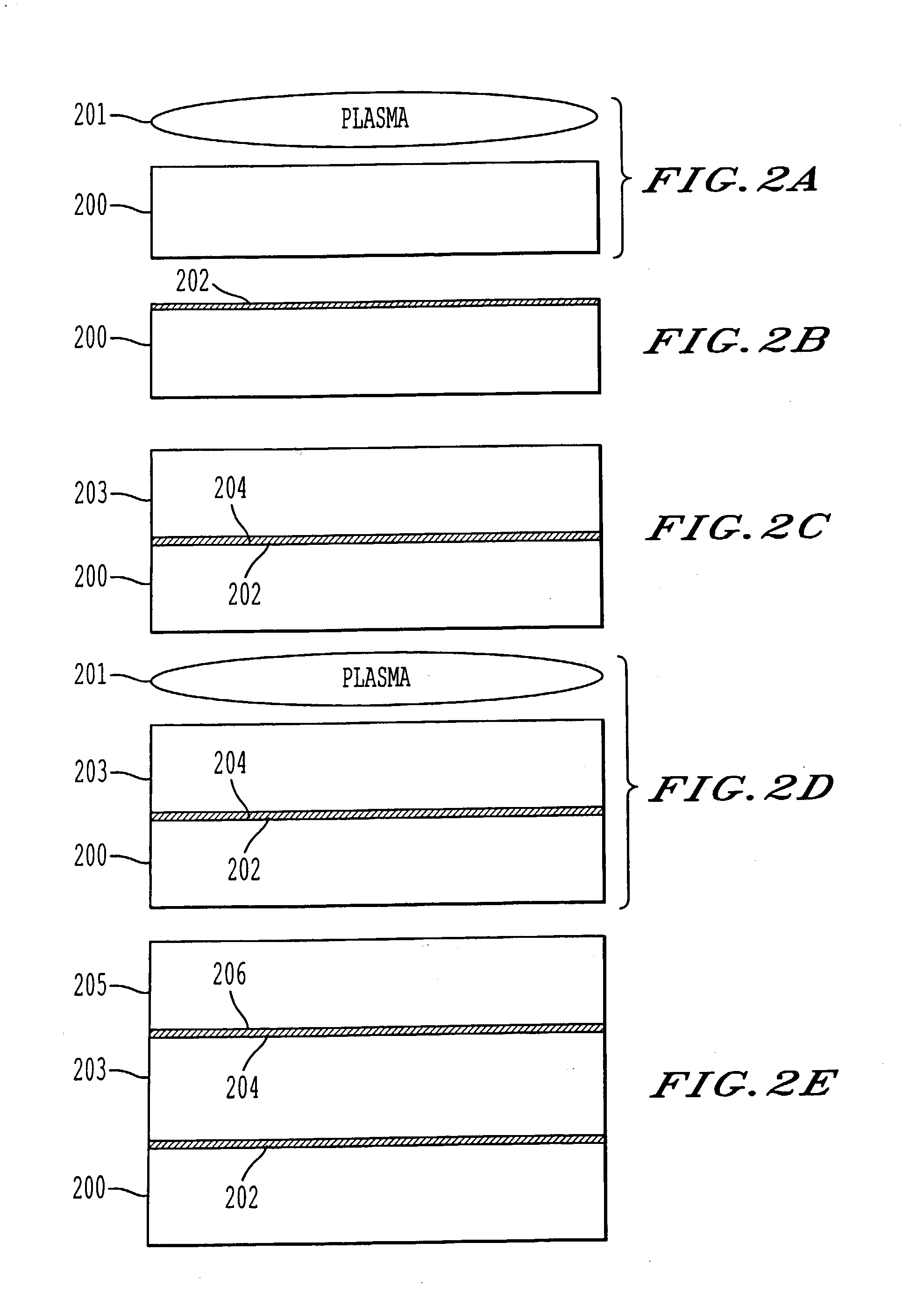Method of epitaxial-like wafer bonding at low temperature and bonded structure
a technology of epitaxial-like wafers and low temperature, applied in the direction of electrical equipment, semiconductor devices, semiconductor/solid-state device details, etc., can solve the problems of large density of threading dislocations in the bulk of the layers, severe and often damaging thermal stresses, and unwanted changes in the bonding material
- Summary
- Abstract
- Description
- Claims
- Application Information
AI Technical Summary
Problems solved by technology
Method used
Image
Examples
third embodiment
[0065] the present invention (shown in FIG. 7) is to use ion implantation to place boron onto the surfaces of bonding substrates. In step 700, the substrates are covered by a masking layer, preferably an oxide layer. The substrates are cleaned using, for example, a wet RCA-1 solution and dried in step 701. Surfaces of the substrates are implanted with boron using BF.sub.3 as shown in step 702 to place the boron concentration peak at the oxide / silicon interface. As an example, forming an 800 .ANG. thick thermal oxide on silicon wafers, boron implantation at an energy of 20 keV with a dose of 5.times.10.sup.14 / cm.sup.2 places boron concentration peak of 6.times.10.sup.19 / cm.sup.2 at the oxide / silicon interface. Employing a 6700 .ANG. thick thermal oxide on silicon wafers, boron implantation at an energy of 180 keV with a dose of 5.times.10.sup.14 / cm.sup.2 places boron concentration peak of 2.5.times.10.sup.19 / cm.sup.2 at the oxide / silicon interface.
[0066] Following boron implantation,...
fourth embodiment
[0070] the present invention is to use As (arseniic) ion implantation to silicon wafers to form an amorphous layer on the wafer surface. Method steps for an As ion implantation treatment bonding process follow the steps shown in FIG. 1. After cleaning and removing any oxide layer, As ion implantation is performed at an energy of 180 keV with a dose of 9.times.10.sup.14 / cm.sup.2. The As doping concentration peak of 8.times.10.sup.19 / cm.sup.3 is located at .about.1150 .ANG. from the silicon surface. Although this implantation induced a very low As doping on the wafer surface, an amorphous layer with 1650 .ANG. thick was formed as confirmed both by a Monte Carlo simulation and TEM measurement (FIG. 10). The thickness of the amorphous layer can vary and is not limited to the value of this example. For instance, other ions may be implanted to create the amorphous layer. Arsenic is a dopant, and there are applications when it is desired not to dope the substrate so another ion, such as a ...
first embodiment
[0073] The above methods can be applied to other substrate combinations involving materials such as InP, GaAs, Ge, SiC, etc. Using the B.sub.2H.sub.6 plasma treatment process described in the first embodiment to InP / InP epitaxial-like wafer bonding, the bonding energy of the bonded InP / InP pairs reached the (100) InP bulk fracture energy of .about.600 mJ / m.sup.2 after annealing at 200.degree. C. for 24 h. FIG. 13 shows the bonding energy as a function of annealing temperature of the B.sub.2H.sub.6 treated InP / InP wafer pairs. For comparison, the bonding energy as a function of annealing temperature of conventional HF dipped InP / InP pairs is also shown.
[0074] The similar results were obtained for bonding a silicon wafer to an InP wafer. Using the B.sub.2H.sub.6 plasma treatment process described in the first embodiment to Si / InP epitaxial-like wafer bonding, the bonding energy of the bonded Si / InP pairs reached the (100) InP bulk fracture energy of .about.600 mJ / m.sup.2 after anneali...
PUM
 Login to View More
Login to View More Abstract
Description
Claims
Application Information
 Login to View More
Login to View More - R&D
- Intellectual Property
- Life Sciences
- Materials
- Tech Scout
- Unparalleled Data Quality
- Higher Quality Content
- 60% Fewer Hallucinations
Browse by: Latest US Patents, China's latest patents, Technical Efficacy Thesaurus, Application Domain, Technology Topic, Popular Technical Reports.
© 2025 PatSnap. All rights reserved.Legal|Privacy policy|Modern Slavery Act Transparency Statement|Sitemap|About US| Contact US: help@patsnap.com



